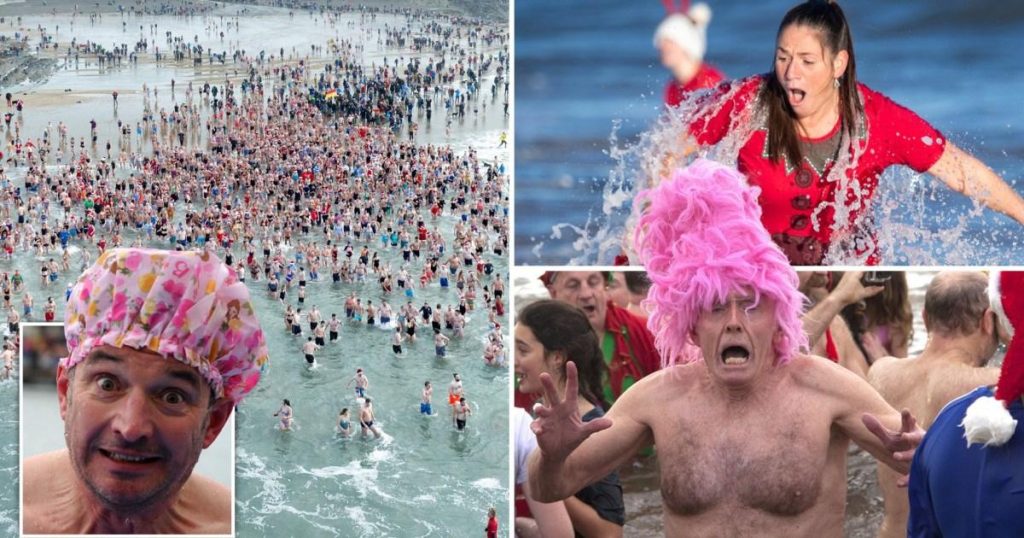The festive period is traditionally a time of giving, and while many express this through gifts or charitable donations, a growing number of individuals choose a more invigorating approach: plunging into the icy embrace of the sea. Boxing Day and New Year’s Day dips have surged in popularity, drawing crowds of participants, often adorned in festive attire, to beaches across the UK. This trend coincides with the rising interest in wild swimming, a practice that eschews the controlled environment of pools for the invigorating challenge of natural bodies of water. The question arises: what compels individuals to partake in this chilling tradition year after year?
The motivations behind these icy plunges are multifaceted, encompassing physical and mental health benefits, community spirit, and charitable giving. Organizers of these events, like Ryan Hope of the Weymouth Christmas Harbour Swim, highlight the sense of festive fun, community pride, and charitable generosity that permeates these gatherings. Thousands of spectators cheer on hundreds of swimmers, creating a vibrant and supportive atmosphere. For participants like Jenny Urwin, co-founder of a cold-water swimming gear company, the initial shock of the cold morphed into an addictive pursuit. She describes the experience as a “revitalizing rush” that triggers a cascade of “happy hormones,” leading to feelings of euphoria and sustained energy.
Beyond the immediate rush, cold water swimming offers a range of potential health benefits. The exposure to cold activates the vagus nerve, which can contribute to lower blood pressure, stress reduction, and improved cardiovascular health. Furthermore, regular cold water immersion is believed to strengthen the immune system, offering resilience against seasonal illnesses. The mental fortitude required to brave the icy waters also fosters a sense of accomplishment and empowerment, leaving swimmers with a feeling that they can conquer any challenge. This combination of physical and mental benefits transforms the seemingly daunting prospect of a cold water dip into an appealing and rewarding experience.
However, the allure of cold water swimming should not overshadow the inherent risks. The RNLI emphasizes the dangers of cold water shock and hypothermia, particularly during the winter months. Water temperatures of 15°C or below can trigger cold water shock, a physiological response that can lead to panic and difficulty breathing. Hypothermia, a dangerous drop in body temperature, poses a further risk. The RNLI recommends several safety precautions, including swimming with a group, wearing bright attire and a tow float for visibility, staying within one’s depth, and consulting a healthcare professional before participating, especially for first-timers. In case of difficulty, floating on one’s back with ears submerged is advised, followed by calling for help or swimming to safety if possible.
The mental health benefits of wild swimming are equally compelling. Psychotherapist Laura Greenwood credits wild swimming with helping her rediscover herself after the birth of her child. She describes the experience as initially ambivalent but ultimately transformative, providing a sense of grounding and well-being during times of emotional and physical dysregulation. This sentiment is echoed by Katherine Cavallo, a psychotherapist and spokesperson for the UK Council for Psychotherapy, who notes that studies have shown a reduction in cortisol (the stress hormone) and an increase in serotonin, dopamine, and endorphins (neurochemicals associated with happiness and relaxation) following wild swimming. This chemical cocktail contributes to the feelings of calm, presence, and exhilaration that keep swimmers returning for more.
The growing popularity of New Year’s Day dips is evident in the numerous organized events taking place across the UK. From Abersoch in Wales to Southend in England, these events offer a unique and invigorating way to celebrate the new year while raising money for charity. Many dips encourage fancy dress, adding an element of fun and spectacle to the proceedings. Whether motivated by charity, the pursuit of physical and mental well-being, or simply the thrill of the challenge, these icy plunges have become a cherished tradition for many, a testament to the human spirit’s ability to find joy and resilience in the face of adversity. The camaraderie, the sense of accomplishment, and the invigorating shock of the cold combine to create an experience that is both challenging and rewarding, leaving participants with a renewed sense of purpose and a lasting connection to the natural world.











